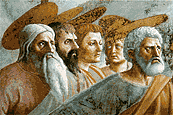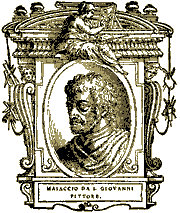Painter
San Giovanni Valdarno 1401-Rome 1428
Tommaso di ser Giovanni di Mone Cassai (San Giovanni Valdarno 1401- Rome
1428). He was one of the most important painters of the 15th century and
the founder of Renaissance painting. He took up the inheritance of
Giotto, developing it according to the new techniques and methods of perspective,
thus giving the human figure a completely new, freer and more concrete position
in the world.
He was extremely young when he came to Florence and was to form part of the circle
around Masolino da Panicale, also from his home town and
twenty years his senior, though apparently their relationship was not that of
teacher and pupil. Rather, it seems that the presence of the already brilliant
Masaccio, with the introduction of the new rules of perspective and naturalism,
was to give new impulse to Masolino's work, which had hitherto tended to keep
to late Gothic models.
He was admitted, like most of the other artists, to the Guild of Doctors and
Herbalists in 1422: his first work, carried out with Masolino, was the Madonna
and Child and St. Anne (Sant'Anna Metterza, 1424-25), previously in the church
of Sant'Ambrogio and now in the Uffizi. He was
in Rome with Masolino for the Jubilee in 1425: together they painted the Polyptych
of the Snow in Santa Maria Maggiore.

The Trinity in
St. Maria Novella
However his first important work was the Trinity in Santa Maria Novella, where he made the maximum use of the rules of perspective, while he worked on his own to carry out the beautiful Polyptych in the church of the Carmine at Pisa (1426), commissioned by the notary Giuliano degli Scarsi. Unfortunately much of his work is scattered about the world: the Madonna and Child in London (National Gallery), the Crucifixion in Naples (Capodimonte) and the Adoration of the Magi in Berlin (Staat Museum). Other works are to be found in Pisa and Vienna.


Frescoes in St. Maria del Carmine
Brancacci Chapel
He went back to working with Masolino again between
1425 and 1427 in what was to be his most important work: the series of
frescoes in the Brancacci Chapel in Santa Maria del Carmine. They are
considered to be the first real paintings of the Renaissance. Masaccio
was to condense the ideas behind the new naturalistic revolution in his
stories of St. Peter and the Original Sin: the space was divided up according
to the rules of scientific perspective, light came from a precise direction
and the shadows gave depth and great intensity to the figures; this
was a holy story which found itself in the reality of the moment and
was told with great simplicity.
This cycle of frescoes found immediate fame and is extremely important in the
history of painting: Alberti and Leonardo wrote about
it, Michelangelo studied it, it was mentioned by historians
and writers and, lastly, it was saved from destruction in the 17th century by
the artists of Florence, who rebelled against the plans of the owners of the
Chapel to reconstruct it in Baroque style.

